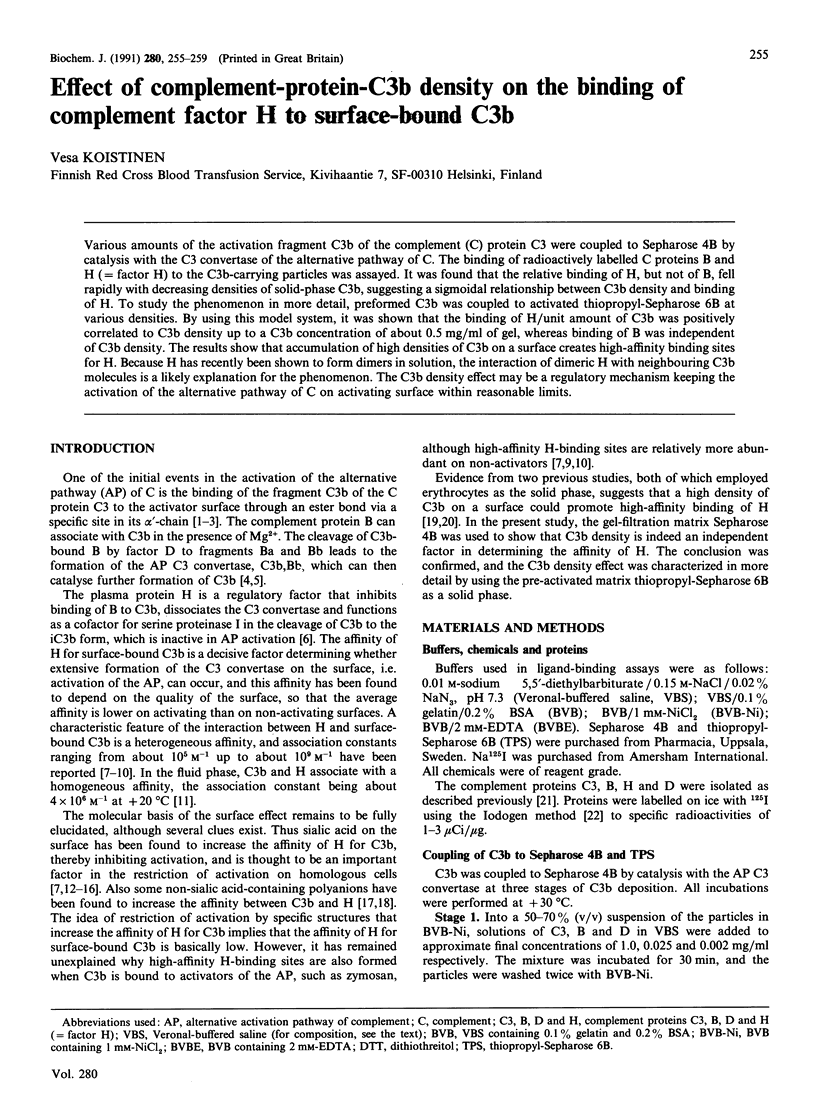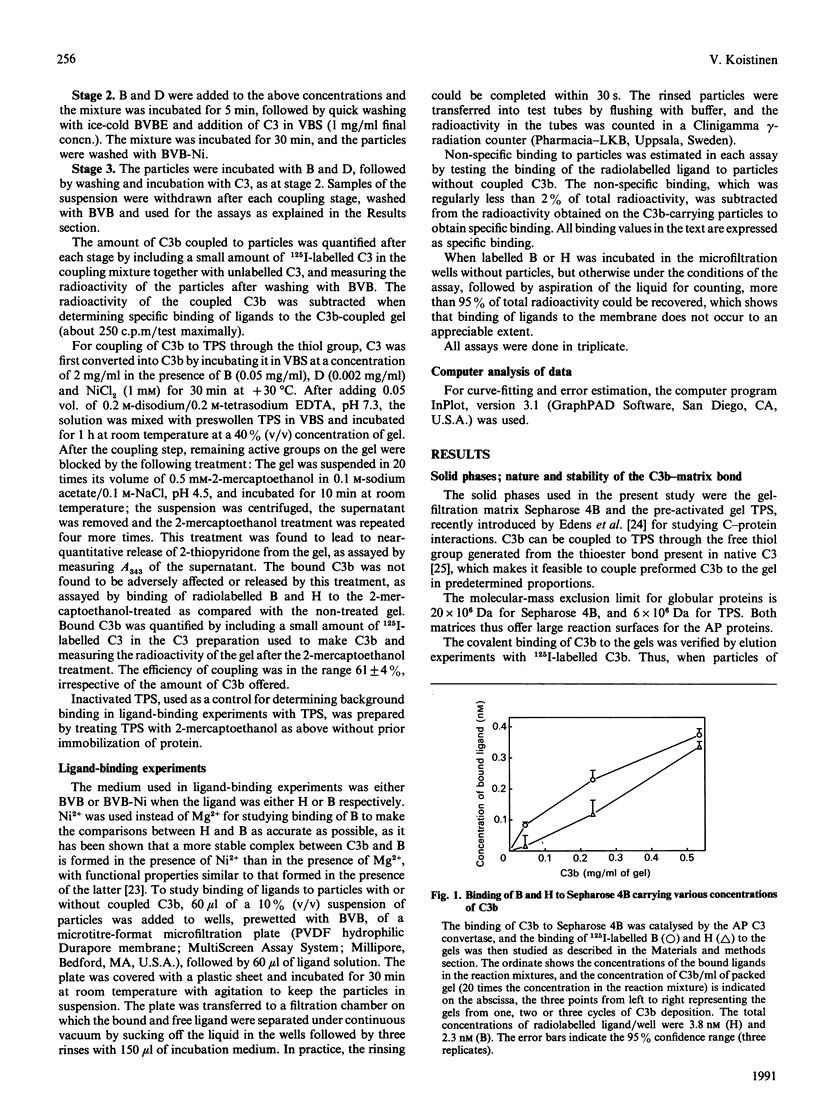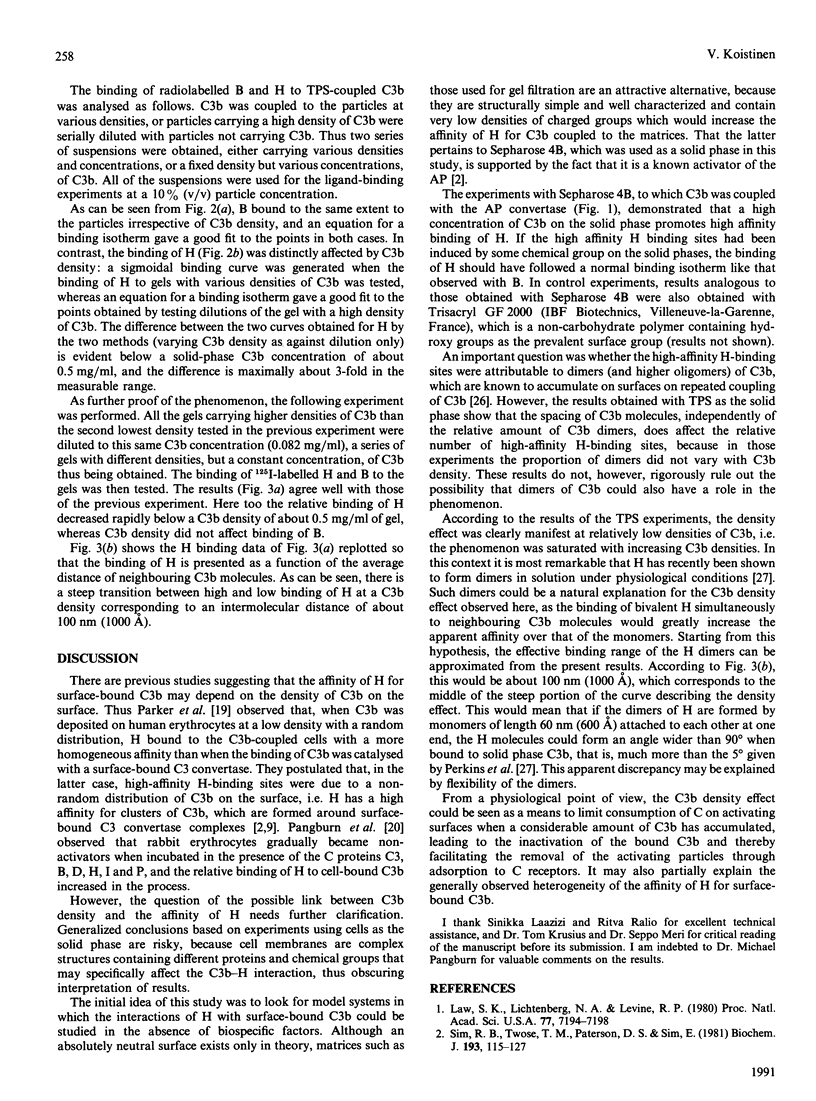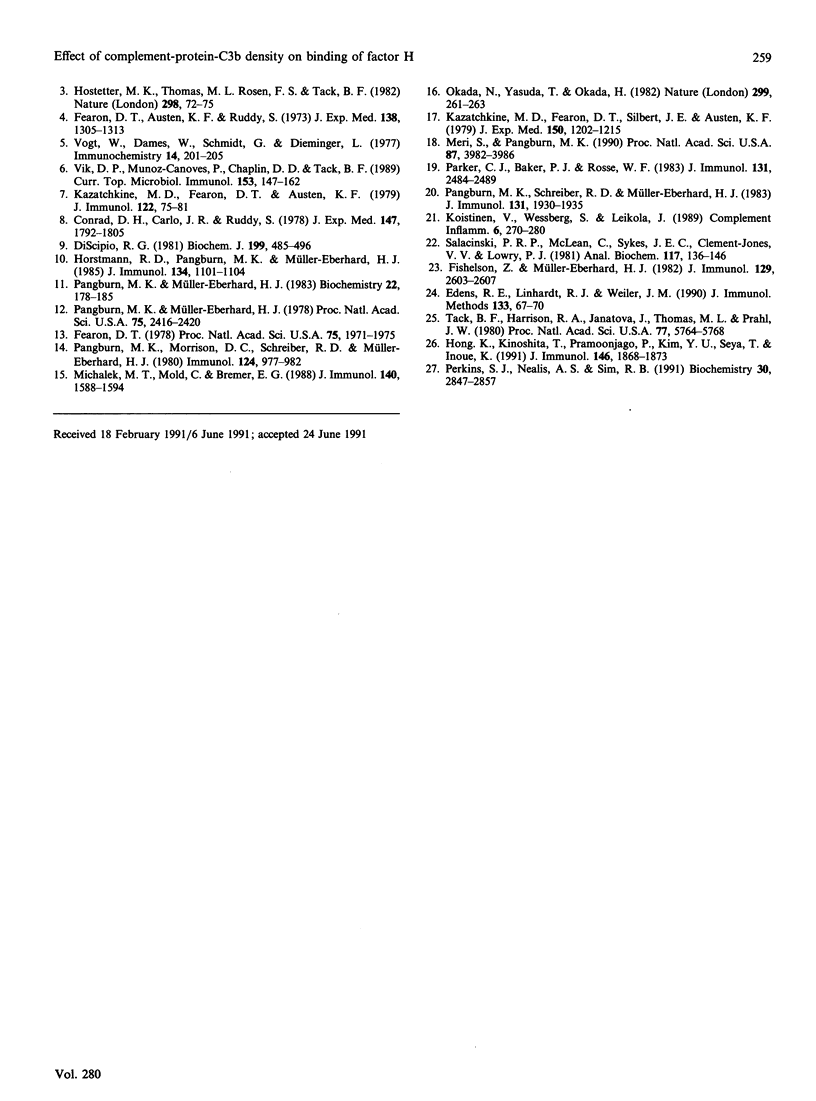Abstract
Various amounts of the activation fragment C3b of the complement (C) protein C3 were coupled to Sepharose 4B by catalysis with the C3 convertase of the alternative pathway of C. The binding of radioactively labelled C proteins B and H (= factor H) to the C3b-carrying particles was assayed. It was found that the relative binding of H, but not of B, fell rapidly with decreasing densities of solid-phase C3b, suggesting a sigmoidal relationship between C3b density and binding of H. To study the phenomenon in more detail, preformed C3b was coupled to activated thiopropyl-Sepharose 6B at various densities. By using this model system, it was shown that the binding of H/unit amount of C3b was positively correlated to C3b density up to a C3b concentration of about 0.5 mg/ml of gel, whereas binding of B was independent of C3b density. The results show that accumulation of high densities of C3b on a surface creates high-affinity binding sites for H. Because H has recently been shown to form dimers in solution, the interaction of dimeric H with neighbouring C3b molecules is a likely explanation for the phenomenon. The C3b density effect may be a regulatory mechanism keeping the activation of the alternative pathway of C on activating surface within reasonable limits.
Full text
PDF




Selected References
These references are in PubMed. This may not be the complete list of references from this article.
- Conrad D. H., Carlo J. R., Ruddy S. Interaction of beta1H globulin with cell-bound C3b: quantitative analysis of binding and influence of alternative pathway components on binding. J Exp Med. 1978 Jun 1;147(6):1792–1805. doi: 10.1084/jem.147.6.1792. [DOI] [PMC free article] [PubMed] [Google Scholar]
- DiScipio R. G. The binding of human complement proteins C5, factor B, beta 1H and properdin to complement fragment C3b on zymosan. Biochem J. 1981 Dec 1;199(3):485–496. doi: 10.1042/bj1990485. [DOI] [PMC free article] [PubMed] [Google Scholar]
- Edens R. E., Linhardt R. J., Weiler J. M. Immobilization of C3b with retention of functional activity. J Immunol Methods. 1990 Oct 4;133(1):67–70. doi: 10.1016/0022-1759(90)90319-q. [DOI] [PubMed] [Google Scholar]
- Fearon D. T., Austen K. F., Ruddy S. Formation of a hemolytically active cellular intermediate by the interaction between properdin factors B and D and the activated third component of complement. J Exp Med. 1973 Dec 1;138(6):1305–1313. doi: 10.1084/jem.138.6.1305. [DOI] [PMC free article] [PubMed] [Google Scholar]
- Fearon D. T. Regulation by membrane sialic acid of beta1H-dependent decay-dissociation of amplification C3 convertase of the alternative complement pathway. Proc Natl Acad Sci U S A. 1978 Apr;75(4):1971–1975. doi: 10.1073/pnas.75.4.1971. [DOI] [PMC free article] [PubMed] [Google Scholar]
- Fishelson Z., Müller-Eberhard H. J. C3 convertase of human complement: enhanced formation and stability of the enzyme generated with nickel instead of magnesium. J Immunol. 1982 Dec;129(6):2603–2607. [PubMed] [Google Scholar]
- Hong K., Kinoshita T., Pramoonjago P., Kim Y. U., Seya T., Inoue K. Reconstitution of C5 convertase of the alternative complement pathway with isolated C3b dimer and factors B and D. J Immunol. 1991 Mar 15;146(6):1868–1873. [PubMed] [Google Scholar]
- Horstmann R. D., Pangburn M. K., Müller-Eberhard H. J. Species specificity of recognition by the alternative pathway of complement. J Immunol. 1985 Feb;134(2):1101–1104. [PubMed] [Google Scholar]
- Hostetter M. K., Thomas M. L., Rosen F. S., Tack B. F. Binding of C3b proceeds by a transesterification reaction at the thiolester site. Nature. 1982 Jul 1;298(5869):72–75. doi: 10.1038/298072b0. [DOI] [PubMed] [Google Scholar]
- Kazatchkine M. D., Fearon D. T., Austen K. F. Human alternative complement pathway: membrane-associated sialic acid regulates the competition between B and beta1 H for cell-bound C3b. J Immunol. 1979 Jan;122(1):75–81. [PubMed] [Google Scholar]
- Kazatchkine M. D., Fearon D. T., Silbert J. E., Austen K. F. Surface-associated heparin inhibits zymosan-induced activation of the human alternative complement pathway by augmenting the regulatory action of the control proteins on particle-bound C3b. J Exp Med. 1979 Nov 1;150(5):1202–1215. doi: 10.1084/jem.150.5.1202. [DOI] [PMC free article] [PubMed] [Google Scholar]
- Koistinen V., Wessberg S., Leikola J. Common binding region of complement factors B, H and CR1 on C3b revealed by monoclonal anti-C3d. Complement Inflamm. 1989;6(4):270–280. doi: 10.1159/000463102. [DOI] [PubMed] [Google Scholar]
- Law S. K., Lichtenberg N. A., Levine R. P. Covalent binding and hemolytic activity of complement proteins. Proc Natl Acad Sci U S A. 1980 Dec;77(12):7194–7198. doi: 10.1073/pnas.77.12.7194. [DOI] [PMC free article] [PubMed] [Google Scholar]
- Meri S., Pangburn M. K. Discrimination between activators and nonactivators of the alternative pathway of complement: regulation via a sialic acid/polyanion binding site on factor H. Proc Natl Acad Sci U S A. 1990 May;87(10):3982–3986. doi: 10.1073/pnas.87.10.3982. [DOI] [PMC free article] [PubMed] [Google Scholar]
- Michalek M. T., Mold C., Bremer E. G. Inhibition of the alternative pathway of human complement by structural analogues of sialic acid. J Immunol. 1988 Mar 1;140(5):1588–1594. [PubMed] [Google Scholar]
- Okada N., Yasuda T., Okada H. Restriction of alternative complement pathway activation by sialosylglycolipids. Nature. 1982 Sep 16;299(5880):261–263. doi: 10.1038/299261a0. [DOI] [PubMed] [Google Scholar]
- Pangburn M. K., Morrison D. C., Schreiber R. D., Müller-Eberhard H. J. Activation of the alternative complement pathway: recognition of surface structures on activators by bound C3b. J Immunol. 1980 Feb;124(2):977–982. [PubMed] [Google Scholar]
- Pangburn M. K., Müller-Eberhard H. J. Complement C3 convertase: cell surface restriction of beta1H control and generation of restriction on neuraminidase-treated cells. Proc Natl Acad Sci U S A. 1978 May;75(5):2416–2420. doi: 10.1073/pnas.75.5.2416. [DOI] [PMC free article] [PubMed] [Google Scholar]
- Pangburn M. K., Müller-Eberhard H. J. Kinetic and thermodynamic analysis of the control of C3b by the complement regulatory proteins factors H and I. Biochemistry. 1983 Jan 4;22(1):178–185. doi: 10.1021/bi00270a026. [DOI] [PubMed] [Google Scholar]
- Pangburn M. K., Schreiber R. D., Müller-Eberhard H. J. C3b deposition during activation of the alternative complement pathway and the effect of deposition on the activating surface. J Immunol. 1983 Oct;131(4):1930–1935. [PubMed] [Google Scholar]
- Parker C. J., Baker P. J., Rosse W. F. Comparison of binding characteristics of factors B and H to C3b on normal and paroxysmal nocturnal hemoglobinuria erythrocytes. J Immunol. 1983 Nov;131(5):2484–2489. [PubMed] [Google Scholar]
- Perkins S. J., Nealis A. S., Sim R. B. Oligomeric domain structure of human complement factor H by X-ray and neutron solution scattering. Biochemistry. 1991 Mar 19;30(11):2847–2857. doi: 10.1021/bi00225a017. [DOI] [PubMed] [Google Scholar]
- Salacinski P. R., McLean C., Sykes J. E., Clement-Jones V. V., Lowry P. J. Iodination of proteins, glycoproteins, and peptides using a solid-phase oxidizing agent, 1,3,4,6-tetrachloro-3 alpha,6 alpha-diphenyl glycoluril (Iodogen). Anal Biochem. 1981 Oct;117(1):136–146. doi: 10.1016/0003-2697(81)90703-x. [DOI] [PubMed] [Google Scholar]
- Sim R. B., Twose T. M., Paterson D. S., Sim E. The covalent-binding reaction of complement component C3. Biochem J. 1981 Jan 1;193(1):115–127. doi: 10.1042/bj1930115. [DOI] [PMC free article] [PubMed] [Google Scholar]
- Tack B. F., Harrison R. A., Janatova J., Thomas M. L., Prahl J. W. Evidence for presence of an internal thiolester bond in third component of human complement. Proc Natl Acad Sci U S A. 1980 Oct;77(10):5764–5768. doi: 10.1073/pnas.77.10.5764. [DOI] [PMC free article] [PubMed] [Google Scholar]
- Vik D. P., Muñoz-Cánoves P., Chaplin D. D., Tack B. F. Factor H. Curr Top Microbiol Immunol. 1990;153:147–162. doi: 10.1007/978-3-642-74977-3_8. [DOI] [PubMed] [Google Scholar]
- Vogt W., Dames W., Schmidt G., Dieminger L. Complement activation by the properdin system: formation of a stoichiometric. C3 cleaving complex of properdin factor B with C36. Immunochemistry. 1977 Mar;14(3):201–205. doi: 10.1016/0019-2791(77)90195-1. [DOI] [PubMed] [Google Scholar]


